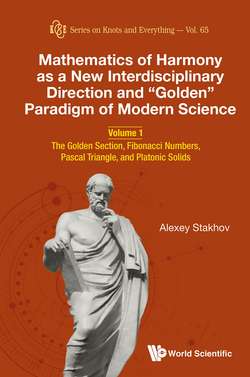Читать книгу Mathematics of Harmony as a New Interdisciplinary Direction and “Golden” Paradigm of Modern Science - Alexey Stakhov - Страница 27
На сайте Литреса книга снята с продажи.
1.2.3. Comments of Mordukhai-Boltovsky, concerning the golden section
ОглавлениеEuclid’s Elements are translated into many languages of the world. The most authoritative edition of Euclid’s work in Russian is Euclid’s Elements in translation and with comments by the Russian geometer D.D. Mordukhai-Boltovsky [104–106]. It is interesting to read the following Mordukhai-Boltovsky comments about the golden section:
“Now let’s see what place takes the golden section in Euclid’s Elements. First of all, it should be noted that it is realized in two forms, the difference between which is almost imperceptible for us, but it was very significant in the eyes of the Greek mathematicians of the 5th–6th centuries BC. The first form, the prototype of which we saw in Egypt, is in Book II of the Elements, namely in Proposition II.11, together with the sentences 5 and 6 that introduce it; here the golden section is defined as such in which the area of a square, built on a bigger segment, equals to the area of a rectangle, built on the entire straight line and the smaller segment.
The second form we have in Definition 3 of Book VI, where the golden section is determined by the proportion, like the whole straight line to the larger segment, and the larger segment to the smaller one, and is called the division in extreme and mean ratio; in this form the golden section could only be known from Eudoxus’ time . . .
In Book XIII, the golden section appears in both of these forms, namely in the first form in Propositions 1–5 and in the second form in Propositions 8–10 . . . Moreover, Proposition 2 of Book XIII is essentially equivalent to the geometric construction of Proposition 11 of Book II.
All this allows to think that Propositions 4, 7, 8 of Book II and Propositions 1–5 of Book XIII represent the remains of one of the most ancient documents in the history of Greek geometry, which most probably goes back to the first half of the 5th century and originated in the Pythagorean school on the basis of the material that was brought from Egypt. . .”
We can draw the following conclusions from these comments:
(1) First of all, Euclid’s Elements contains not just one (Proposition II.11), but at least two different formulations of the golden section. As follows from the comments of Mordukhai-Boltovsky, Euclid widely uses in his Elements both the first form (Proposition II.11 of Book II and Propositions 1–5 of Book XIII) and the second form as a representation of the golden section in the form of a proportion (Proposition 3 of Book VI and Propositions 8–10 of Book XIII).
(2) In the golden section (Proposition II.11), Mordukhai-Boltovsky sees the “Egyptian trace” and clearly hints at Pythagoras, who spent 22 years in Egypt and brought from there a huge amount of Egyptian mathematical knowledge, including the “Pythagoras theorem” and the golden section. Hence, it follows from Mordukhai-Boltovsky’s comments that Mordukhai-Boltovsky did not doubt that not only Euclid, but also Pythagoras and Plato (who was a Pythagorean), and also the ancient Egyptians knew about the golden section and widely used it (in what follows, we will demonstrate this by analyzing the geometric model of the Cheops Pyramid as an example).
